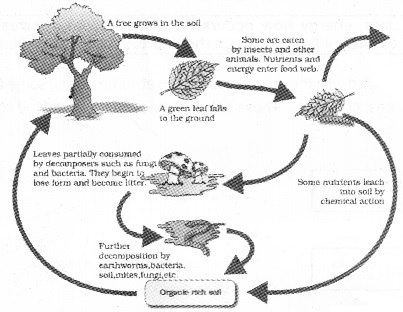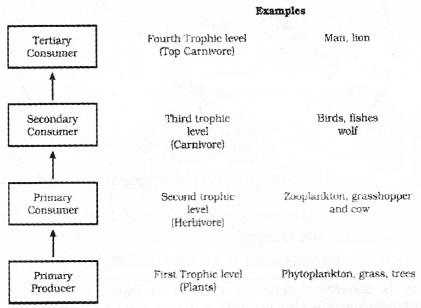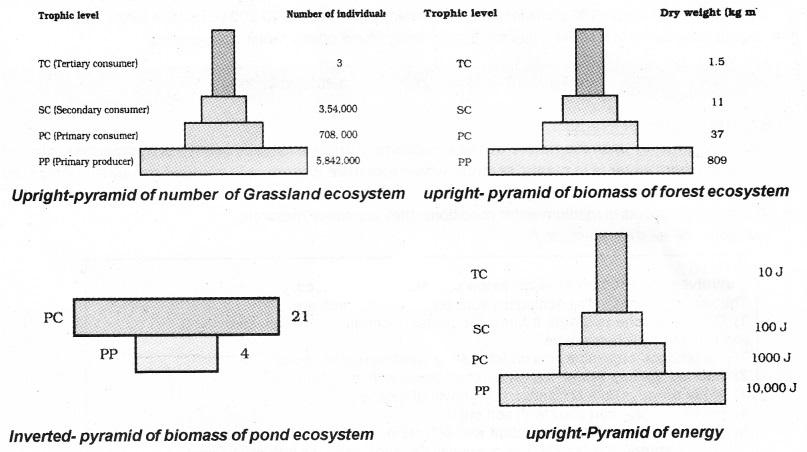Plus Two Botany Notes Chapter 7 Ecosystem is part of Plus Two Botany Notes. Here we have given Plus Two Botany Notes Chapter 7 Ecosystem.
| Board | SCERT, Kerala |
| Text Book | NCERT Based |
| Class | Plus Two |
| Subject | Botany Notes |
| Chapter | Chapter 7 |
| Chapter Name | Ecosystem |
| Category | Plus Two Kerala |
Kerala Plus Two Botany Notes Chapter 7 Ecosystem
Ecosystem – structure And Function
Interaction of biotic and abiotic components form the physical structure that is characteristic for each type of ecosystem. Different types of plant and animal species of an ecosystem gives its species composition. Life of species occupying different strata is called stratification For example, trees occupy top vertical strata of a forest, shrubs and herbs and grasses occupy the bottom layers.
| The components of the ecosystem are seen to function as a unit, they are |
| (i) Productivity; (ii) Decomposition; (iii) Energy flow; and (iv) Nutrient cycling. |
Productivity
The primary energy source for functioning of an ecosystem is solar energy.
| The amount of food energy produced by a particular trophic level per unit area in a time or rate of biomass production is called productivity. |
It is highest in a coral reef of aquatic ecosystems and in tropical rain forest of terrestrial ecosystems
Productivity is of two types
(a) Primary productivity:
It refers to the productivity at producer level. It is divided into two
- Gross primary productivity – It refers to total photosynthesis i.e total amount of food formed by the producers
- Net primary productivity – It refers to gross production minus losses by respiration and decomposition.
![]()
(b) Secondary productivity:
It is defined as the rate of formation of new organic matter by consumers. The annual net primary productivity of the whole biosphere is approximately 170 billion tons (dry weight) of organic matter.
Decomposition
| Decomposition is the process by which complex organic compounds are broken into simpler and inorganic substances. |
Decomposition is a complex process of enzymatic reaction and involves the step-wise degradation of detritus (dead organic matter and excreta of animals and plants). It involves following processes.
Fragmentation of detritus:
Leaching:
It is process by which simple and water soluble compounds like simple sugars and inorganic nutrients move downward along with percolating gravitational water.
Catabolism:
It is the enzymatic break down of organic compound.
Humification:
It is process by which simplified detritus is changed into dark coloured amorphous substance called humus.
Mineralisation:
It involves the release of inorganic subtances (Water, C02, etc) and other nutrients (NH4+, Ca++, Mg++, K+, etc.) in the soil.
Decomposition cycle in terrestrial ecosystem:

Decomposition is largely an oxygen-requiring process. The rate of decomposition is controlled by chemical composition of detritus and climatic factors.
| Decomposition rate is slower if detritus is rich in lignin and chitin, and quicker, if detritus is rich in nitrogen and water-soluble substances like sugars. |
| Warm and moist environment favour decomposition whereas low temperature and anaerobic condition inhibit decomposition and accumulation of organic materials. |
Energy flow
Of the incident solar radiation less than 50 percent of it is photosynthetically active radiation (PAR). Plants capture only 2-10 percent of the PAR. solar energy captured by plants flows through different organisms of an ecosystem.
Energy flow is the key function of an ecosystem. It is determined by two basic laws of thermodynamics.
First law of thermodynamics states that energy is neither created nor destroyed, but can betransffered from one component to another, or transformed from one state to another.
Second law of thermodynamics states that every energy transformation involves degradation or dissipation of energy from a concentrated to a dispersed form due to metabolic functions. Dissipation of energy occures as heat. The remaining energy used in the synthesis of plant biomass.
Producers in a terrestrial ecosystem, include herbaceous and woody plants and an aquatic ecosystem are species like phytoplankton, algae, and higher plants. The energy trapped by the producer is passed on to a consumer.
They are hence called consumers. If animals feed on the producers, they are called primary consumers (herbivores.), and if the animals eat other animals which in turn eat the plants they are called secondary consumers.
The consumers that feed on these herbivores are carnivores, i.e primary carnivores Those animals that depend on the primary carnivores for food are called as secondary carnivores.
A simple grazing food chain (GFC) is depicted below:

The detritus food chain (DFC) begins with dead organic matter. It is made up of decomposers which are heterotrophic organisms, mainly fungi, and bacteria. They get energy from dead organic matter or detritus. These are also known as saprotrophs.
| In an aquatic ecosystem, energy flow occurs through GFC. In a terrestrial ecosystem, a much larger fraction of energy flows through the detritus food chain than through the GFC. |
Detritus food chain is connected with the grazing food chain at some levels: some animals in an ecosystem are Omnivores, eg-cockroaches, crows, etc. These natural interconnections of food chains make it a food web.
Trophic levels in an ecosystem:

The different steps of food chain is known as trophic level. Producers belong to the first trophic level, herbivores (primary consumer) to the second and carnivores (secondary consumer) to the third. The amount of energy decreases at successive trophic levels. Detritus or dead biomass that serves as an energy source for decomposers.
| Each trophic level has a certain mass of living material at a particular time called as the standing crop. The standing crop is measured as the mass of living organisms (biomass). |
| In food chain the energy transfer from one trophic level to the next is 10%. |
Energy flow through different trophic levels:

Ecological pyramids
An ecological pyramid is a graphical representation of an ecological parameter, like number or biomass or accumulated energy at different trophic levels in a food chain in as ecosystem.
The three ecological pyramids are
| (a) pyramid of number; (b) pyramid of biomass and (c) pyramid of energy. |
The idea of ecological pyramids was developed by Charles Elton. An ecological pyramid may be upright (taping towards the tip) or inverted (widens towards the tip).

The base of each pyramid represents the producers or the first trophic level while the apex represents tertiary or top level consumer.
In most ecosystems, all the pyramids, of number, of energy, and biomass are upright, i.e., producers are more in number and biomass than the herbivores, and herbivores are more in number and biomass than the carnivores. Also energy at a lower trophic level is always more than at a higher level.
| The pyramid of biomass in sea is inverted because the biomass of fishes is more than Phytoplankton. Pyramid of energy is always upright, because energy level decreases in successive trophic level some energy is always lost as heat at each step. |
Ecological Succession
The successive replacement of biotic communities in an area over a period of time is known as ecological or biotic succession.
| The first community to inhabit area is called pioneer community while the last and stable community in an area is called climax community. The intermediate communities between the pioneer and climax communities are called transitional or serai communities. |
Basic types of succession:
Primary succession:
Primary succession which starts from the primitive substratum, where there was no previously any sort of living matter e.g. land formed by volcanic lava, development of forest climax on a barren land may take about 1,000 years.
Secondary Succession:
Secondary succession which starts from previously built up substrata with already existing living matter. Such areas include burned or cut forests, flooded lands, etc. such successions are comparatively more rapid. Time taken is about 50 – 100 years in case of a grassland and about 100 – 200 years for a forest.
1. Succession of Plants:
Depending mainly upon the nature of the environment succession is of two types hydrarch-starting in regions where water is in plenty, xerarch- where moisture is present in minimal amounts such as dry deserts, rocks, etc.
If succession occurs in medium water conditions, they are called mesarch.
| Xerarch It involves the ecological succession on bare rock surfaces. The various stages in the ecological succession in a xerarch are (1) Crustose lichens stage – It forms the poineer community in a lithosere and is represented by lichen species. These produce organic acids which cause weathering of rocks. (2) Foliose lichens stage – It includes the lichens with leafy thalli. (3) Moss stage – It is characterised by growth of mosses (4) Herbs stage – short plant with soft stem (5) Shrub stage – medium sized plant with soft stem (6) Forest stage – It is the climax community depends upon the nature of climate eg a rain forest in a moist tropical area; a coniferrous forest or deciduous forest in temperature area; a grassland in area with less rainfall etc. |
Hydrarch:
It involves the ecological succession in the newly formed pond or lake.

| (a) phytoplankton stage. (b) Submerged plant stage. Hydrilla, Vallisneria, Utricularia (c) Submerged free floating plant Stage -It includes nymphaea.nelumbium, etc. (d) Reed swamp stage. It is also called amphibious stage It includes the plant species like sagittaria, Typha etc. (f) Marsh – meadow stage. It is mainly formed of plant species like Carex (sedge). They form a mat-like vegetation towards the centre of the pond (g) Scrub stage. In this stage the area is invaded by some shrubby plants which can tolerate bright sunlight as well as waterlogged conditions (h) Forest stage. It is the climax community |
Nutrient Cycling
| The amount of nutrients, such as carbon, nitrogen, phosphorus, calcium, etc. present in the soil at any given time, is referred to as the standing state. |
It varies in different kinds of ecosystems. Nutrients are continuously exchanged between organisms and their physical environment. These exchanges are called nutrient cycling / biogeochemical cycles.
Nutrient cycles are of two types:
- gaseous and
- sedimentary
Cycles of gaseous matter are called gaseous cycles. The reservoir of gaseous matter is atmosphere, (e.g.,
nitrogen, carbon cycle).
Cycles of mineral matter are called Sedimentary cycles. The reservoir of mineral matter is lithosphere, (e.g., sulphur and phosphorus cycle.)
1. Ecosystem – Carbon Cycle:
Carbon cycling occurs through atmosphere, ocean and through living and dead organisms. The amount of carbon fixed in the biosphere through photosynthesis annually is 4 × 1013 kg. Decomposition of dead organic matter and fossil fuel, through respiratory activities, burning of wood, forest fire, deforestation and volcanic activity releasing CO2 in the atmosphere.
Carbon cycle in biosphere:

2. Ecosystem – Phosphorus Cycle:
Phosphorus is a major component of biological membranes, nucleic acids, and cellular energy transfer systems. The natural reservoir of phosphorus is rock, which contains phosphorus in the form of phosphates.
When rocks are weathered, minute amounts of these phosphates dissolve in soil solution and are absorbed by the roots of the plants. The waste products and the dead organisms are decomposed by phosphate-solubilizing bacteria releasing phosphorus.
Ecosystem Services
The products of ecosystem processes are named as ecosystem services, for example,
| healthy forest ecosystems purify air and water, mitigate droughts and floods, cycle nutrients, generate fertile soils, provide wildlife habitat, maintain biodiversity, pollinate crops, provide storage site for carbon and also provide aesthetic, cultural and spiritual values. |
Robert Constanza and his colleagues have very recently tried to put price tags on nature’s life-support services. Researchers have put an average price tag of US 33trillionayearonthesefundamentalecosystemsservices.ItisnearlytwicethevalueoftheglobalgrossnationalproductGNPwhichisUS 18 trillion. Out of the total cost of various ecosystem services.
| The soil formation accounts for about 60 per cent, and contributions of other services like recreation and nutrient cycling, are less than 10 per cent each. The cost of climate regulation and habitat for wildlife are about 6 per cent each. |
We hope the Plus Two Botany Notes Chapter 7 Ecosystem help you. If you have any query regarding Plus Two Botany Notes Chapter 7 Ecosystem, drop a comment below and we will get back to you at the earliest.
